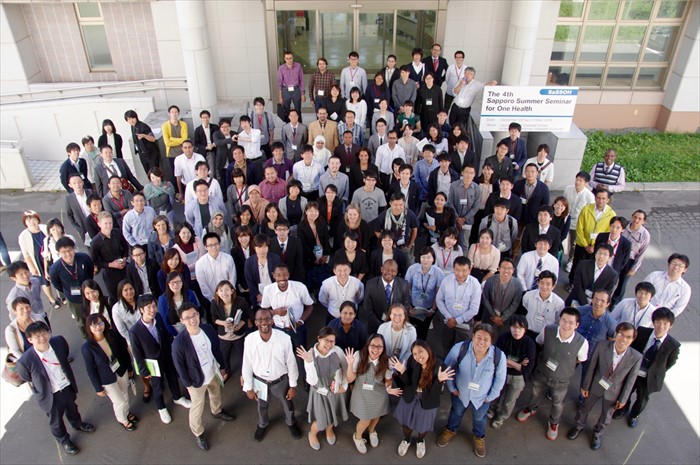- Home
- Previous SaSSOH
- The 4th SaSSOH, 2016
The 4th SaSSOH, 2016
The unique point of 4th SaSSOH is active discussion to expand our points of view for One Health. Participants expanded their ideas by coming up with hypothetical theme in each group under the main theme “How does your research contribute to One Health?”. Student session organized by students themselves was also discussion session based on role playing, which turns out that students also wanted to have discussion to expand their ideas in addition to ordinal research presentation.

Date
September 20-21, 2016
Invited Speakers
- Ana Maria Bispo de Filippis
Head, Flavivirus Laboratory, Oswaldo Cruz Institute, Fiocruz, Rio de Janeiro, Brazil
Zika virus in Brazil: knows and unknows
- Monica K. H. Bando
PhD student, Department of Veterinary Clinical Sciences, College of Veterinary Medicine, Washington State University, USA
Bear Bile Farming: Health, Welfare and Conservation Consequences for Endangered Moon Bears
- Mitsuru Miyata
Executive Leader Writer, Nikkei Business Publicationsm Inc., Associate Professor, Prefectural University of Kumamoto, Japan
The Japanese Challenge for Promoting Biotechnology in 21st Century
- Salome Durr
Veterinary Public Health Institute, Vetsuisse Faculty, University of Bern, Switzerland
One Health ? definition, added value and challenges on the example of canine rabies
- Yoko Aoyama
Regional Veterinary Officer, Regional Representation for Asia and the Pacific, World Organisation for Animal Health (OIE), Japan
OIE’s approach to the One Health concept
- Boripat Siriaroonrat
Assistant Director of Conservation & Research, Zoological Park Organization, Thailand
Needs & Gaps Identification, Strategy and Implementation of Integrated Actions under One Health Approach for Wildlife Health Sector
- Bon-Kyoung Koo
Group Leader, WT-MRC, Cambridge Stem Cell Institute, the University of Cambridge, UK
CRISP/Cas-assisted genetics in intestinal organoids
- Masanori Imamura
Assistant Professor, Department of Molecular and Cellular Biology Primate Research Institute, Kyoto University, Japan
Evolutional Developmental Biology and Medicine with Primate Stem Cells
- Julie A. Moreno
Post-doctoral Fellow, Prion Research Center, Department of Microbiology, Immunology and Pathology, Immunology and Pathology, Colorado State University, USA
Targeting cellular stress pathways for prevention of neurodegeneration
Award
- Best Oral Presentation Award
- Suranji Wijekoon (Laboratory of Veterinary Surgery, Graduate School of Veterinary Medicine, Hokkaido University)
- Best Poster Presentation Award
- Jin Suzuki (Yamaguchi University)
- Best Question Award
- Misaki Tanaka (Laboratory of Veterinary Hygiene, Graduate School of Veterinary Medicine, Hokkaido University)
Organizing Committee
- Keisuke Aoshima
Laboratory of Comparative Pathology, Graduate School of Veterinary Medicine, Hokkaido University
- Soichiro Yamaguchi
Laboratory of Pharmacology, Graduate School of Veterinary Medicine, Hokkaido University
- Michael Henshaw
Teacher of English as a Foreign Language, Leading Program, Graduate School of Veterinary Medicine, Hokkaido University
- Hiroshi Ohta
Laboratory of Veterinary Internal Medicine, Graduate School of Veterinary Medicine, Hokkaido University
- Manabu Igarashi
Division of Global Epidemiology, Research Center for Zoonosis Control, Hokkaido University
- Junya Yamagishi
Division of Collaboration and Education, Research Center for Zoonosis Control, Hokkaido University
- Mariko Sashika
Laboratory of Wildlife Biology and Medicine, Graduate School of Veterinary Medicine, Hokkaido University
- Takahiro Hiono
Laboratory of Microbiology, Graduate School of Veterinary Medicine, Hokkaido University
Student Committee
- Lesa Angela Thompson
Laboratory of Toxicology, Graduate School of Veterinary Medicine, Hokkaido University
- Suranji Wijekoon
Laboratory of Veterinary Surgery, Graduate School of Veterinary Medicine, Hokkaido University
- Suppalak Kaewkwan
Laboratory of Wildlife Biology and Medicine, Graduate School of Veterinary Medicine, Hokkaido University
- Md. Atiqul Islam
Laboratory of Laboratory Animal Science and Medicine, Graduate School of Veterinary Medicine, Hokkaido University
